Archive for the ‘Kitchen Memories’ Category


Home Front Friday is a regular series that highlights the can do spirit on the Home Front during World War II and illustrates how that spirit is still alive today!
Letters are one of the most common World War II artifacts. During World War II troops stationed all over the world corresponded with people on the Home Front through V-Mail, a technology at the time that saved valuable cargo space by converting letters to microfilm stateside, then the negatives would be blown up and printed before being delivered. As primary sources, letters sent by V-mail offer great insight into how soldiers and their loved ones handled things like shortages, rationing, and the fear of war.
-
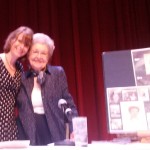
- Authors of "Life Between the Letters: The Chuck and Mary Felder Story"
-
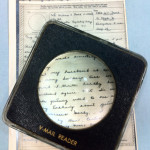
- V-Mail reader
-
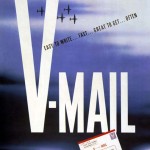
- V-Mail propaganda
Learn more about V-Mail in our Take a Closer Look Gallery.
This week we hosted a Meet the Author event featuring Lana Lynne Higginbotham and Mary Felder about their book Life Between the Letters: The Chuck and Mary Felder Story. Felder spent the evening sharing her World War II love story, preserved through letters, and published with co-author Higginbotham. The book particularly focuses on the correspondence the couple sent each other for V-J Day as that anniversary is this week. Before email and text messaging, those on the Home Front might hear from their loved one overseas only occasionally, even if they diligently wrote letters daily, due to the reality of fast-moving divisions and combat conditions. Mary shared her correspondence with her husband Chuck. Many of her family were present at the event and the stories, while personal to Mary, remind us of how every single person alive during World War II has their own story.
If you have any World War II memories you would like to share, check out our guidelines for conducting an oral history or consider finding out about daily life on the Home Front, particularly in the kitchen, by sending in Kitchen Memories.
Posted by Lauren Handley, Education Programs Coordinator at The National WWII Museum



During wartime, a large emphasis was placed on growing produce at home and not wasting any food. Meat was also rationed. Our Victory Belle Cristina has a great fall Lentil Stew recipe that uses ingredients that were common in WWII Victory Gardens and that were mindful of the time’s rations. Give it a try and follow the instructions below!
Cristina’s Lentil Stew- Serves 4
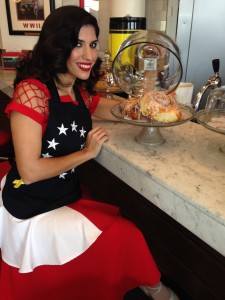
Our Victory Belle Cristina has a hearty fall recipe to share with you!
As a very busy Victory Belle, health is a top priority! With performances filling up the calendar, we’ve got to be ready to go at any moment. This means making sure we are getting enough sleep and eating well. This Lentil Stew recipe is a perfect fall dish that’s full of vitamins, fiber, folate, and antioxidants. This dish keeps The Victory Belles satisfied and energized enough to get through our high energy shows—and it tastes great!
This one pot of Lentil Stew can be served as a main dish or a side. Lentils have very little calories (about 280 cal. for 1 cup of cooked lentils) and a lot of fiber. So they’ll fill you up—not out! Kale is full of antioxidants and is an anti-inflammatory too. Both kale and lentils are known to help in the prevention of certain cancers and heart diseases.
Ingredients:
1 small onion, chopped
1/2 cup finely chopped carrots
1 cup peeled eggplant, cut into small pieces
1 to 2 cups of chopped kale
Olive oil
Seasonings: rosemary, cumin, herbs de provence, salt, and pepper
3 cups of liquid (water, broth, or combination of the two)
1 cup of dry green lentils
1-2 tablespoons of Sherry Vinegar
1-2 tablespoons of lemon juice
Garnishes: fresh parsley and parmesan cheese
Rinse and Prep the Vegetables-
- Peel and cube eggplant, and put in a colander over the sink. Then salt the eggplant, and let it sit for 20-30 minutes to help get rid of the eggplant’s bitter liquid. Once the eggplant has been salted for about 30 minutes, rinse the pieces with water and pat dry each cube with a paper towel.
- While the eggplant is sitting, chop up onions and carrots into bite size pieces.
- For the kale, cut into bite-sized chunks or ribbons removing the hearty center stem on each leaf.
Cooking-
- Add olive oil into a big pot (I prefer cast iron) heating over medium heat.
- When the oil heats up begin to add onions, carrots, eggplant, and kale seasoning each layer of vegetables added with shakes of rosemary, cumin, herbs de provence, salt, pepper or whatever other flavors you prefer.
- Once the vegetables begins to cook down add the 3 cups of liquid to the pot with the 1 cup of dry green lentils.
- Bring this mixture to a boil and let simmer for 4 hours. Be sure to check it periodically adding more flavors and bits of lemon juice and Sherry Vinegar to taste.
Tips for seasoning:
Fresh herbs are always a plus. With this dish, earthy flavors work well, but feel free to add the notes you love most.
Hope you enjoy one of my favorite recipes!
-Cristina



In the wake of wartime consumer restrictions, the draft, and questionable news from the front, Americans were in desperate need of light hearted distraction and social interaction. With a great deal of food and raw materials being rationed, how did industrious American homemakers manage to entertain without compromising the needs of their families? Well, they had to get creative. Humor, informality, and a little imagination were the keys to successful wartime entertainment. The Ladies Home Journal, Betty Crocker, and various other publications all offered party ideas, menus, and activities designed to be easy on the pocket book and on ration points.
Betty Crocker, in the pamphlet “Your Share” suggested Hobo Parties complete with tattered cloths and a menu of peanut butter and jelly sandwiches, pickles, and other easy things. The centerpiece should be a stewing kettle over a fake fire made with crumpled red paper. Décor included tin cups and plates. After supper all could sit around the open fire and tell stories or sing old-time songs. Fun, easy, and economical.
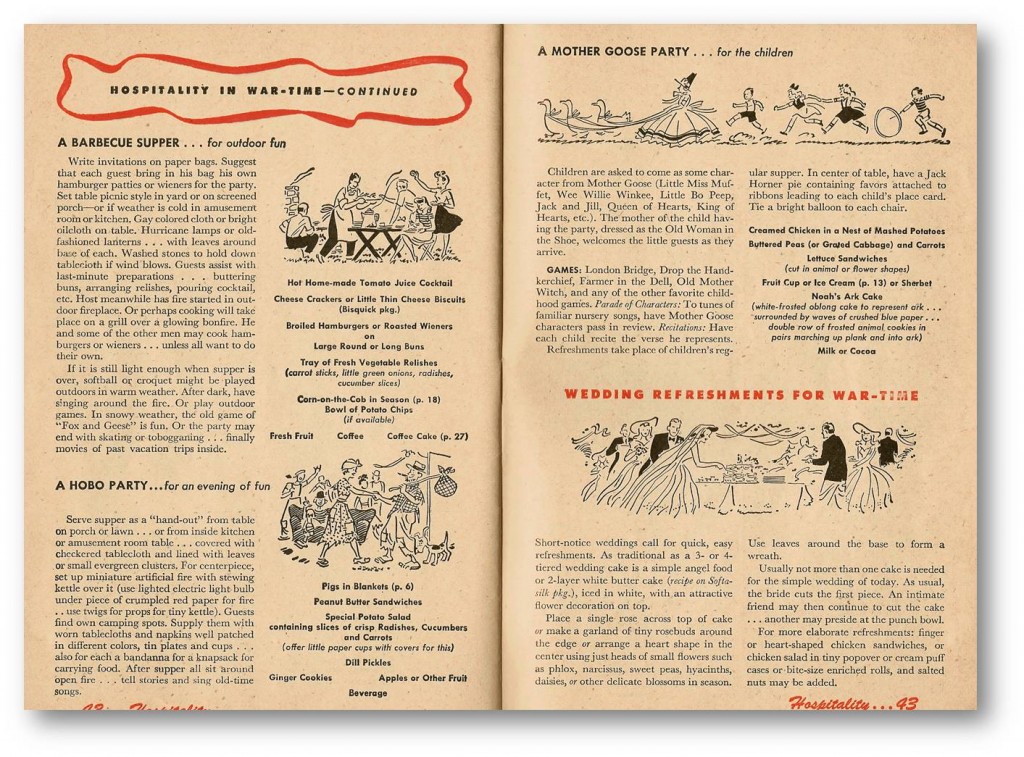
Share your memories of wartime entertaining and parties at our Kitchen Memories site today!
Post by Anna Wysuph, Education Intern at The National WWII Museum



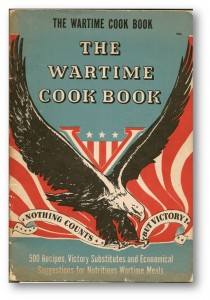
With the implementation of wartime consumer food rations beginning in 1942, American women faced the daunting task of not only feeding their families but keeping them satisfied and happy. With many foods, such as sugar, butter, and meat, in short supply, women were forced to change their usual methods of buying, preparing, and serving food. To assist women in their patriotic duty of putting food on the family table, a variety of “Wartime Cookbooks” were published and distributed. These small, mass produced cookbooks provided tips for maximizing the potential of ration points, methods for utilizing leftovers and eliminating waste, and new recipes to allow families to enjoy “delicious and nutritious” meals while not using more than their fare share.
Wartime cookbooks advocated unique food combinations and substitutions, as well as several unusual recipes. Women were encouraged to buy less desirable cuts of meat, such as organ meat, due to its lower point value, save all cooking byproducts, such as meat drippings, and to substitute sugar for nontraditional sweeteners such as molasses, honey, corn-syrup, and even marshmallows. Some of the new recipes provided included Sweet and Sour Tongue, Chicken or Ham Mold, and Peanut Butter and Chili Sauce Sandwiches. Yum?
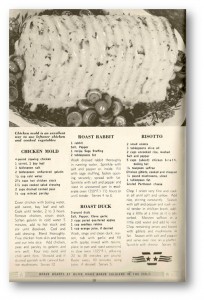
Share your memories of wartime cookbooks and their recipes at our Kitchen Memories site today!
Post by Anna Wysuph, Education Intern at The National WWII Museum.



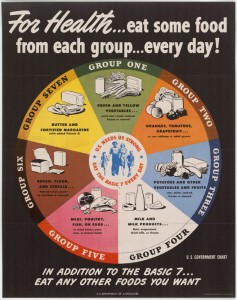
Before food was organized into cohesive groups or placed into a pyramid or a plate, the United States Department of Agriculture introduced the Basic 7 Food Chart. Developed in 1943 as part of the nationwide implementation of wartime food rationing, the “Basic 7” stressed the need to maintain proper nutrition and healthy eating habits that were compatible with the limitation of certain foods. The Basic 7 food groups were:
- Green and yellow vegetables (some raw; some cooked, frozen or canned)
- Oranges, tomatoes, grapefruit (or raw cabbage or salad greens)
- Potatoes and other vegetables and fruits (raw, dried, cooked, frozen or canned)
- Milk and milk products (fluid, evaporated, dried milk, or cheese)
- Meat, poultry, fish, or eggs (or dried beans, peas, nuts, or peanut butter)
- Bread, flour, and cereals (natural whole grain, or enriched or restored)
- Butter and fortified margarine (with added Vitamin A)
The USDA stressed the importance of groups one through three not only for their nutritional value, but due to the fact that the foods included could all be grown to some degree in personal Victory Gardens, thus saving ration points for more limited items such as meat and sugar. It is also interesting that butter was a category unto itself.
Share your stories of the Basic 7 Food Chart at our Kitchen Memories site today.
Post by Anna Wysuph, Education Intern at The National WWII Museum



A few years ago we asked people to send us their memories of food and eating during World War II. We had some great responses, but we know there are more out there so we are asking you to help! If you have memories of the kitchen from the war years, please send them to us. We’d love your stories, recipes, and memories. If you were born after World War II, this is a great opportunity to talk to those who did experience both good and bad meals during wartime.
Each Friday we will publish food stories on our blog. Our goal is to produce a publication that will be available for free download on our website, so that all who are interested can read the stories and try the recipes we receive. Please talk to the war generation, from veterans to kids on the home front, and share their stories with us.
Here’s an example of a great memory that Carl Jensen of Cotati, CA sent in:
“My mom and pop decided to raise rabbits for meat. Because of pop’s increased income at the shipyard, we could afford to rent a bigger house. It also had more land where we could keep some chickens for eggs and pop could build the rabbit cages. We got two pairs of male and female rabbits and we waited. And the rabbits did what rabbits do, and soon we had more than a half-dozen of the cuddly creatures. Finally, the time had come to kill and dress the rabbits as planned. Mom and I anxiously stayed in the house while pop took the axe and went out to the rabbit hutches. We waited. And we waited. Pop finally came back into the house. “I can’t do it,” he said. Mom and I yelled with happiness and we all trailed out to the backyard to watch the newly reprieved rabbits in their cages.”
To help us preserve these recollections, stories, and recipes, here are some questions to fire up your memories:
- What do you remember about food rationing during the war?
- Do you remember using substitutes for unavailable ingredients?
- Did you or anyone you know shop on the “black market”?
- Did you grow a Victory garden?
- What about holiday meals?
- What about working or eating in local restaurants?
- What was your greatest food challenge during the war?
- What was your favorite food during the war?
- What was your least favorite?
Do you remember any unique recipes (triumphs or disasters) that came out of your Home Front kitchen?
Let’s talk about food!
Send your memories to kitchenmemories@nationalww2museum.org today.
Posted by Lauren Handley, Education Programs Coordinator












